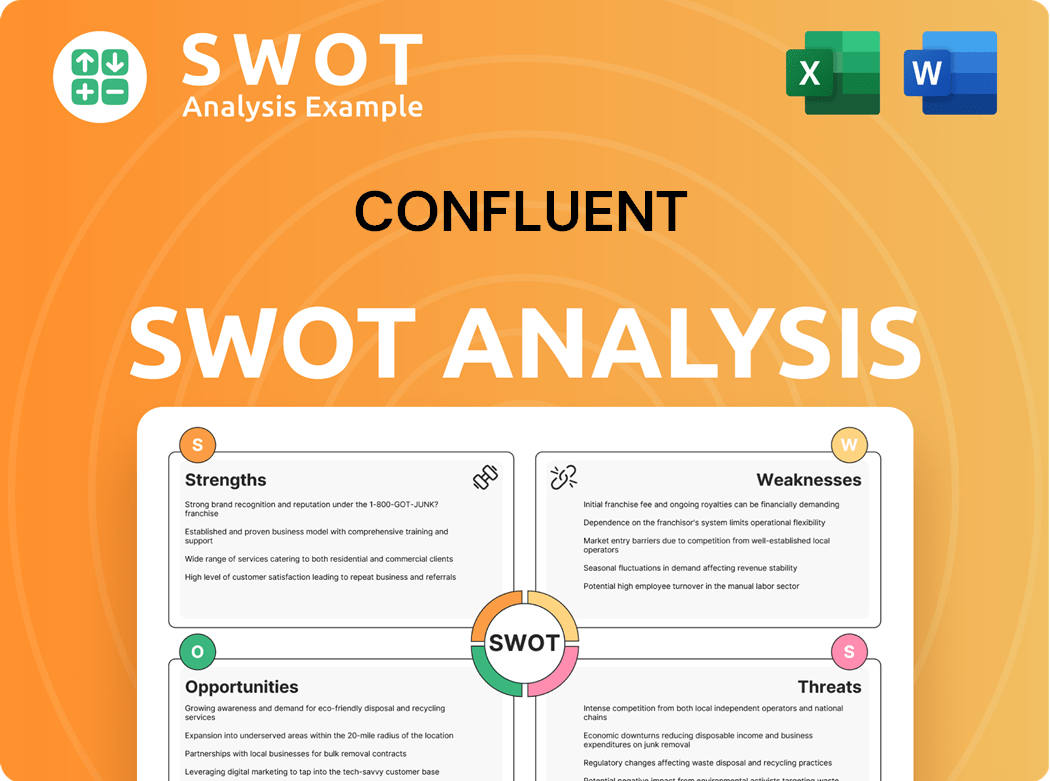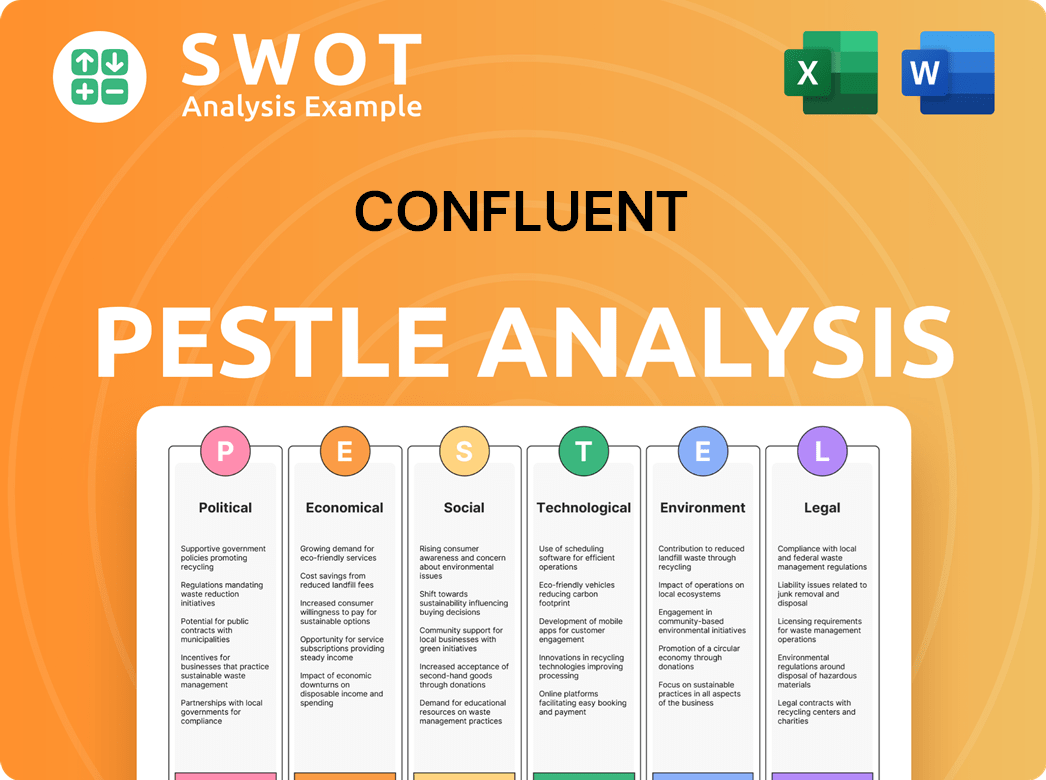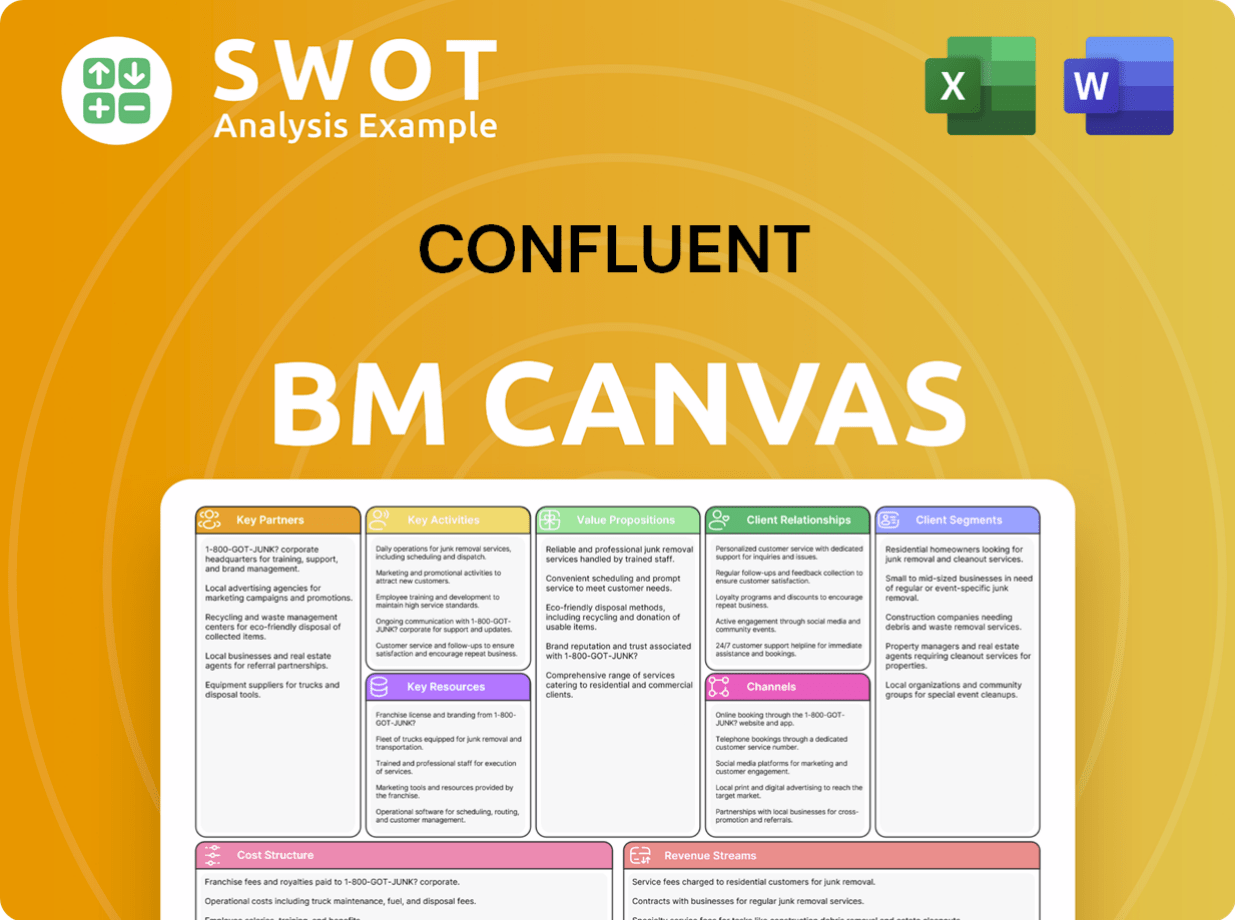Confluent Bundle
How Does Confluent Stack Up in the Data Streaming Arena?
In today's fast-paced digital world, real-time data is king, and Confluent has emerged as a key player in managing it. Born from the creators of Apache Kafka, Confluent offers a powerful data streaming platform designed to help businesses harness the power of live data. But how does Confluent navigate the complex and competitive landscape of data streaming?

To truly understand Confluent's position, we must dive deep into its Confluent SWOT Analysis and its rivals. This Confluent market analysis will explore the company's competitive advantages and disadvantages, examining its key competitors and their offerings. We'll also investigate Confluent's pricing, customer base, and the industries it serves, providing a comprehensive view of the Confluent competitive landscape and its future prospects. This includes a comparison of Confluent vs. Apache Kafka and other Kafka alternatives.
Where Does Confluent’ Stand in the Current Market?
Confluent maintains a leading position in the data streaming platform market. Its core operations revolve around providing a robust enterprise-grade Apache Kafka distribution and cloud-native services. This focus allows businesses to process real-time data efficiently. The company's value proposition lies in enabling organizations to build event-driven architectures, which are crucial for modern applications.
The company offers two primary product lines: Confluent Platform, designed for on-premises deployments, and Confluent Cloud, a fully managed cloud service. The strong growth of Confluent Cloud reflects the increasing industry trend toward cloud adoption and managed services, making real-time data processing more accessible and scalable for various businesses. This strategic shift has broadened its customer base.
Confluent's market position is consistently recognized as a frontrunner in the streaming data and event-driven architecture space. The company's ability to provide scalable and accessible streaming platforms has allowed it to attract a wider array of customers. This has expanded its reach beyond traditional on-premises deployments, solidifying its competitive edge in the data streaming solutions market.
Confluent is a leading player in the data streaming platform market. It offers enterprise-grade solutions built around Apache Kafka. This helps businesses manage and process real-time data effectively.
Confluent provides two main products: Confluent Platform for on-premises use and Confluent Cloud, a fully managed cloud service. Confluent Cloud's growth highlights the shift towards cloud-based solutions. This makes it easier for businesses to adopt real-time data processing.
Confluent has a strong presence in North America, Europe, and Asia-Pacific. It serves a diverse customer base across various sectors. This widespread presence helps Confluent maintain its competitive edge.
For fiscal year 2023, Confluent reported revenues of $689 million, marking a 33% year-over-year increase. Confluent Cloud revenue grew by 48% to $305 million. This financial performance underscores Confluent's strong market position and growth potential.
Confluent serves a diverse customer base, ranging from large enterprises to smaller organizations. These organizations span sectors such as financial services, retail, technology, and manufacturing. The ability to cater to various customer needs contributes to Confluent's success.
- Large enterprises use Confluent for mission-critical data infrastructure.
- Smaller organizations leverage real-time data for competitive advantage.
- The company's focus on cloud offerings attracts a wider customer base.
- Confluent's growth strategy is detailed further in this article about the Growth Strategy of Confluent.
Confluent SWOT Analysis
- Complete SWOT Breakdown
- Fully Customizable
- Editable in Excel & Word
- Professional Formatting
- Investor-Ready Format

Who Are the Main Competitors Challenging Confluent?
The competitive landscape for Confluent is shaped by a mix of established tech giants and specialized providers. Understanding the Confluent competitive landscape is crucial for anyone evaluating its market position and future prospects. This analysis considers both direct and indirect competitors, offering a comprehensive Confluent market analysis.
Confluent faces competition from cloud providers, open-source solutions, and other real-time data processing platforms. The battlegrounds include features, ease of use, and pricing, particularly in the managed service sector. This overview helps clarify Confluent competitors and their impact on the company.
Confluent operates in a competitive environment, contending with both established technology giants and agile, specialized providers. Its primary competitors include other managed Kafka providers and companies offering real-time data processing solutions. Cloud providers, such as Amazon Web Services (AWS) with Amazon MSK (Managed Streaming for Kafka), Microsoft Azure with Azure Event Hubs and Azure Stream Analytics, and Google Cloud with Google Cloud Pub/Sub and Dataflow, present significant competition. These hyperscalers leverage their extensive cloud infrastructure and integrated service offerings to attract customers.
AWS, Microsoft Azure, and Google Cloud offer managed Kafka services and competing real-time data processing solutions. These providers often bundle their services, influencing pricing and customer acquisition. Their extensive cloud infrastructure gives them a broad reach.
Red Hat (with AMQ Streams based on Kafka) and other open-source solutions offer alternatives to Confluent's platform. These competitors may focus on specific features or target different customer segments. The open-source model can influence pricing and adoption strategies.
Various smaller players specialize in streaming analytics or event processing platforms, competing with Confluent's broader capabilities. These platforms may target niche markets or offer unique features. They can disrupt the market with innovative solutions.
Traditional data warehousing and database providers are evolving to include real-time capabilities, posing indirect competition. These providers may integrate streaming features into their existing offerings. Their established customer base can be a significant advantage.
Confluent emphasizes enterprise-grade features and operational expertise to differentiate itself. This focus helps it compete against the more generalized offerings of cloud providers. This includes features like advanced security, governance, and support.
Emerging players in the streaming database and real-time analytics space continuously disrupt the landscape. These new entrants push the boundaries of what's possible with real-time data. Innovation is a key factor in this dynamic market.
Indirect competition also comes from traditional data warehousing and database providers as they evolve their offerings to include real-time capabilities. High-profile battles often revolve around feature sets, ease of use, scalability, and Confluent pricing, particularly in the managed service space where cloud providers can bundle services. For instance, Confluent has emphasized its enterprise-grade features and operational expertise as a differentiator against the more generalized offerings of cloud providers. Emerging players in the streaming database and real-time analytics space are also continuously disrupting the landscape, pushing the boundaries of what's possible with real-time data. For more insights, see the Target Market of Confluent.
Confluent's advantages include its enterprise-grade features and operational expertise, but it faces challenges from cloud providers' bundled services and open-source alternatives.
- Advantages: Enterprise-grade features, operational expertise, strong focus on Kafka, and integrations.
- Disadvantages: Higher pricing compared to open-source options, competition from bundled cloud services, and the need to continually innovate.
- Market Share: While precise market share figures vary, Confluent is a leader in the managed Kafka space, competing with AWS, Azure, and Google Cloud.
- Pricing Strategies: Confluent employs various pricing tiers based on usage and features, targeting different customer needs.
Confluent PESTLE Analysis
- Covers All 6 PESTLE Categories
- No Research Needed – Save Hours of Work
- Built by Experts, Trusted by Consultants
- Instant Download, Ready to Use
- 100% Editable, Fully Customizable

What Gives Confluent a Competitive Edge Over Its Rivals?
Understanding the Revenue Streams & Business Model of Confluent is crucial for assessing its competitive standing. The company, built by the original creators of Apache Kafka, possesses a deep understanding of the technology, giving it a significant edge in the Confluent competitive landscape. This expertise allows Confluent to offer superior performance, reliability, and advanced features compared to the open-source version and other Kafka alternatives.
Confluent's competitive advantages are multifaceted, encompassing technological prowess, a robust product suite, and a strong market presence. The company's fully managed service, Confluent Cloud, simplifies the operational complexities of running Kafka at scale, attracting enterprises seeking to offload infrastructure management. Continuous innovation in Confluent Cloud, including features like ksqlDB, further differentiates its offering within the data streaming solutions review.
Confluent's strong brand equity within the Kafka community and the broader data streaming ecosystem fosters customer loyalty and attracts top talent. Their extensive documentation, training, and support further enhance the customer experience. These advantages have evolved from simply providing a commercial Kafka distribution to offering a comprehensive, cloud-native data streaming platform. While imitation is a constant threat, Confluent's continuous investment in R&D, its deep expertise, and its strong community ties help sustain its competitive edge.
Confluent's founders and engineers have unparalleled expertise in Apache Kafka. This allows for optimized Kafka distributions and a robust ecosystem of connectors, tools, and management features. This deep knowledge base is a key differentiator in the Confluent competitive landscape.
Confluent Cloud offers a fully managed service that simplifies Kafka operations. This cloud-native platform provides high availability, security, and elasticity. This service is a significant advantage for enterprises seeking to offload infrastructure management.
Confluent benefits from a strong brand within the Kafka community. This fosters customer loyalty and attracts top talent. Their extensive documentation, training, and support further enhance the customer experience, contributing to their competitive advantages.
Confluent is continuously investing in R&D to stay ahead of the competition. Features like ksqlDB and Schema Registry are examples of this innovation. This commitment helps sustain its competitive edge in the data streaming solutions market.
Confluent's competitive advantages are rooted in its deep Kafka expertise and cloud-native platform. The company's ability to provide a fully managed service and continuous innovation sets it apart from competitors in the data streaming market. Confluent's market share analysis 2024 shows a steady growth.
- Deep Kafka Expertise: Confluent's founders and engineers have unparalleled expertise in Apache Kafka.
- Confluent Cloud: A fully managed, cloud-native platform that simplifies Kafka operations.
- Strong Brand and Community: Fosters customer loyalty and attracts top talent.
- Continuous Innovation: Ongoing investment in R&D to stay ahead of the competition.
Confluent Business Model Canvas
- Complete 9-Block Business Model Canvas
- Effortlessly Communicate Your Business Strategy
- Investor-Ready BMC Format
- 100% Editable and Customizable
- Clear and Structured Layout

What Industry Trends Are Reshaping Confluent’s Competitive Landscape?
The data streaming industry is experiencing rapid technological advancements, fueled by the growing need for real-time insights and the increasing adoption of cloud-native architectures. This dynamic environment presents both opportunities and challenges for companies like Confluent. A thorough Confluent competitive landscape analysis is crucial for understanding its position and future prospects. The industry is evolving, and staying informed about Confluent competitors and market trends is key.
The competitive landscape is shaped by the proliferation of AI and machine learning applications that demand real-time data feeds, the rise of event-driven architectures, and the shift towards hybrid and multi-cloud deployments. Understanding these trends is vital for assessing the Confluent market analysis and its strategic positioning. The Confluent platform must continually adapt to meet these evolving demands to maintain its competitive edge.
The data streaming industry is witnessing significant growth, driven by the increasing need for real-time data processing. Cloud adoption continues to rise, with hybrid and multi-cloud strategies becoming more prevalent. AI and machine learning applications are driving demand for real-time data feeds.
Intense competition from hyperscale cloud providers poses a significant challenge. Managing the complexity of diverse enterprise environments and ensuring seamless integration is crucial. Data governance and security in streaming data are becoming increasingly important.
Expanding real-time use cases across various industries presents significant growth opportunities. The increasing need for robust data governance and security creates a demand for specialized solutions. Emerging markets offer potential for expansion as more organizations recognize the value of real-time data.
Continued investment in Confluent Cloud is essential. Expanding the ecosystem of connectors and integrations is crucial. Focusing on specialized solutions for key industry verticals can drive market penetration. Deepening integration with AI/ML workflows is a key strategy.
The competitive landscape includes both established players and emerging technologies. Understanding the Confluent vs. Apache Kafka comparison is vital, as is assessing Kafka alternatives. Confluent pricing strategies and Confluent pricing for enterprise customers are important factors.
- Confluent needs to differentiate its offerings from those of hyperscale cloud providers.
- Focus on expanding its ecosystem through connectors and integrations.
- Prioritize data governance and security features to meet enterprise demands.
- Explore partnerships within the broader data ecosystem to enhance its market reach.
The Confluent market share analysis 2024 indicates that the company holds a significant position in the data streaming market, with a substantial Confluent customer base and industries. However, competition remains fierce. A recent report showed that the data streaming market is projected to reach $33.7 billion by 2028, growing at a CAGR of 21.8% from 2021 to 2028. For more insights on Confluent competitive advantages and disadvantages and its Confluent platform features and benefits, consider a Confluent competitive analysis report. The Confluent data streaming solutions review highlights the importance of continuous innovation and strategic partnerships. For a deeper dive into the company's marketing approach, check out the Marketing Strategy of Confluent.
Confluent Porter's Five Forces Analysis
- Covers All 5 Competitive Forces in Detail
- Structured for Consultants, Students, and Founders
- 100% Editable in Microsoft Word & Excel
- Instant Digital Download – Use Immediately
- Compatible with Mac & PC – Fully Unlocked

Related Blogs
- What are Mission Vision & Core Values of Confluent Company?
- What is Growth Strategy and Future Prospects of Confluent Company?
- How Does Confluent Company Work?
- What is Sales and Marketing Strategy of Confluent Company?
- What is Brief History of Confluent Company?
- Who Owns Confluent Company?
- What is Customer Demographics and Target Market of Confluent Company?
Disclaimer
All information, articles, and product details provided on this website are for general informational and educational purposes only. We do not claim any ownership over, nor do we intend to infringe upon, any trademarks, copyrights, logos, brand names, or other intellectual property mentioned or depicted on this site. Such intellectual property remains the property of its respective owners, and any references here are made solely for identification or informational purposes, without implying any affiliation, endorsement, or partnership.
We make no representations or warranties, express or implied, regarding the accuracy, completeness, or suitability of any content or products presented. Nothing on this website should be construed as legal, tax, investment, financial, medical, or other professional advice. In addition, no part of this site—including articles or product references—constitutes a solicitation, recommendation, endorsement, advertisement, or offer to buy or sell any securities, franchises, or other financial instruments, particularly in jurisdictions where such activity would be unlawful.
All content is of a general nature and may not address the specific circumstances of any individual or entity. It is not a substitute for professional advice or services. Any actions you take based on the information provided here are strictly at your own risk. You accept full responsibility for any decisions or outcomes arising from your use of this website and agree to release us from any liability in connection with your use of, or reliance upon, the content or products found herein.